Imagine telling your computer you want a hamburger and it prints one; the democratization of pharmaceuticals; synthetic bacteria that will eat microplastics in the sea; bacteria or fungi that can clear oil spills, using vast algae farms to capture Co2 emissions and being able to take those applications with us when we start exploring new planets, says Prof. Yaakov Nahmias, the director of Hebrew University’s Grass Center for Bioengineering in Israel, a visiting faculty member at Harvard Medical School, a Fellow of the British Royal Society of Medicine and a serial entrepreneur.
These are just some of the ways that Nahmias and other industry pundits believe synthetic biology will transform the world by 2063.
Through a process called molecular ‘pharming’ farmers in the Global South will grow crops of plants that act as miniature bioreactors capable of producing or expressing high value biological molecules, such as proteins, which can be used to locally develop and manufacture therapeutic drugs, vaccines and diagnostics for human and animal health, predicts Paul Freemont,the co-founder of the Imperial College Centre for Synthetic Biology and Innovation and co-founder and co-director of the National UK Innovation and Knowledge Centre for Synthetic Biology (SynbiCITE) and Director of the London BioFoundry at Imperial College.
Synthetic Biology will enable us to increase energy storage and food security and mass produce products more efficiently while improving healthcare for the general population and planetary health, says Claudia Vickers, an Australian bioengineering scientist with over 20 years of experience in academia, government research, and industry who co-chaired the World Economic Forum’s Future Council on Synthetic Biology. What’s more the circular economy will become a reality and cities will be reorganized accordingly. Everything will be produced locally and be recycled and reused, she says.
The supply of raw materials will no longer be constrained by natural availability, predicts the New York-based Future Today Institute in its 2023 report. Drought-stricken communities could produce animal protein and crops regardless of extreme climate events. New “living drugs,” like yeasts that produce malaria defenses, could be deployed quickly and economically in impoverished communities. Cells might be reprogrammed to reverse their aging process and prolong the lifespans of living organisms, including humans.
Welcome to the bioeconomy —economic activity driven by the life sciences, biotechnology, and contributing advances in engineering, computing, and information sciences.
Eric Schmidt, the former executive chairman of Alphabet, calls it the next frontier for innovation. He is advising the U.S. on how to become a leader in the field, kicking off the latest global race amongst nations for technology supremacy.
While the last 30 years were defined by our ability to read DNA the next 30-40 years will be defined by our ability to write it, potentially transforming the way everything is manufactured and helping us tackle some of the world’s biggest challenges, including climate change, disease, and food security. That is why The Innovator, in partnership with the conference PuzzleX, decided to launch its new section FutureScope with an article about synthetic biology.
With its ability to engineer the DNA of microorganisms, and its wide array of applications, synthetic biology offers a valuable “Swiss Army Knife-style solution” to tough challenges if it can be further developed, scaled and become economically viable.
“This feels like the 1990s for computer scientists,” says Nahmias. “Now biology is at the forefront. It’s a new revolution that will require a different set of skills.” New specialty skills in fields such as genomics, molecular biology, biochemistry, and neuroscience will be in increasingly high demand, with good reason. Consulting firms McKinsey and Boston Consulting Group (BCG) are both forecasting that synthetic biology will disrupt nearly every industry.

The Manufacturing Paradigm of The Future
Synthetic biology has turned the science into “the manufacturing paradigm of the future, “ says a BCG report. “Microorganisms can, in theory, make many of the things that industrial processes currently manufacture, so syn-bio—the design and engineering of biological systems to create and improve processes and products—offers new ways of producing almost everything that human beings consume, from flavors and fabrics to foods and fuels.”
Just as arranging zeros and ones enabled all types of information to be communicated digitally, changing the genetic code—A, T, C, and G, which stand for adenine, thymine, cytosine, and guanine, the four nucleotides that form DNA—alters biological systems. New genome-editing technologies, such as CRISPR-Cas9, are helping the creation of novel DNA combinations, reducing the costs of editing DNA, and increasing the length of DNA strands that can be replicated without error, says BCG. The viability of cell-free biology has improved, allowing companies to use metabolic cell processes that don’t need live cells and make testing faster by using biosensors. Like data and cloud computing, DNA and DNA editing are fueling the creation of a new production frontier.
By the end of the decade, synthetic bioligy could be used extensively in manufacturing industries that account for more than a third of global output—almost $30 trillion in terms of value—according to a new BHI study. Some industries are closer to feeling the impact than others. According to BCG’s projections, incumbents in sectors such as health and beauty, medical devices, and electronics will be challenged by syn-bio rivals—as the pharmaceutical and food industries already have been—in the next five years. Other industries, such as chemicals, textiles, fashion, and water, which many start-ups are already targeting, will face cost-based competition from syn-bio alternatives in the medium run, followed in the long term by sectors such as mining, electricity, and even construction.
Impact On Drug Development and Health
The introduction of Generative AI is speeding up the timetable. Just like AI tools like ChatGPT are revolutionizing how the world generates text, images and code, machine learning algorithms and generative AI are upending traditional processes in life sciences and collapsing time frames and drug discovery and materials development.
DeepMind said in July that its AlphaFold2 AI system, first released in July 2021, had been used to predict the structure of nearly all proteins known to science. Meta said on March 16 that its ESMFold system had been used to reveal the structures of an even larger group of proteins, including the least understood ones: those found in microbes in the soil, deep in the ocean, and some inside human bodies.
That’s not all. The recently open-sourced RFDiffusion, a machine learning model allows researchers to generate computational protein designs using just their laptops. Translating those computational designs into physical functioning proteins has remained challenging but in April a Swiss startup called Adaptyv Bio, founded by a group of engineers from EPFL, the Swiss Federal Institute for Technology in Lausanne, announced that it had found a way to create a next-gen protein foundry by combining advanced robotics, micro fluidics, and synthetic biology techniques.
“Proteins are at the core of the bio revolution, whether in the form of new medicines, better enzymes for research and industrial applications or as materials with novel properties,” Julian Englert, CEO and co-founder at Adaptyv Bio said in a statement. “As a protein designer you now have access to incredible new AI tools such as AlphaFold or RFDiffusion. But validating your protein designs in the lab to see if they work remains a huge pain. Imagine every time you used Github Copilot to generate some code you had to wait 10 weeks for it to execute or to tell you that it had a bug. And imagine each execution costs 1000 USD. That’s pretty much the situation for protein designers today.”
The thing that AI models need the most is data, for training them and for improving the predictions they make. By making it easier to generate data about how well the designed proteins work, Adaptyv Bio says it allows protein engineers and AI models to get more feedback about their designs and helps them steer towards better performing proteins. “
Nvidia is also applying generative AI to synthetic biology. In March Nvidia, a U.S. company specializing in AI computing, announced an expanded set of generative AI Cloud services for customizing AI foundation models to accelerate the creation of new proteins and therapeutics, as well as research in the fields of genomics, chemistry, biology, and molecular dynamics.
Part of NVIDIA AI Foundations, the new BioNemo Cloud service offering — for both AI model training and inference — accelerates the most time-consuming and costly stages of drug discovery. It enables researchers to fine-tune generative AI applications on their own proprietary data, and to run AI model inference directly in a web browser or through new loud application programming interfaces (APIs) that integrate into existing applications. Amgen, one of the world’s leading biotechnology companies, is already using the service to advance its research and development efforts.
These advances – along with improvements in cell-based therapies – are expected to finally usher in the age of personalized medicine. “Thanks to the application of AI in less than 10 years Alzheimer’s will be fixable and maybe even cancer,” says a Madrid-based Nvidia executive. “There is amazing progress.”
At the same time, advances in synthetic biology are expected to lead to the democratization of medicine and vaccines.
Tissue Dynamics, a company founded by Nahmias, the director of Hebrew University’s Grass Center for Bioengineering, built an autonomous robotic platform that can simultaneously handle 20,000 micro scale human organs, that more accurately reflect human physiology than methods currently used in drug testing. This robotic system uses sensors embedded in the human tissues to create the organs, screen molecules that are applied to them, identify the ones that work, do safety assessments, and produce final drug treatments using AI-based tools to understand the basic mechanisms of human disease. The technology received the European Seal of Excellence in 2021 and Tissue Dynamics was selected as one of the top five emerging organ-on-chip companies in the world. If it works and the process scales “we think we can reduce the cost of drug development by over 75% from $2.6 billion to half a billion dollars per drug,” says Nahmias.
Synthetic biology companies like the UK’s Leaf Expression Systems are using a different approach to democratizing drugs: harnessing the power of plants for the benefit of wider society. The idea is to use them in the production of proteins to act as therapeutic drugs, diagnostics, and vaccines.
With the right tweaks plants can act as as ‘mini-bioreactors’ in much the same way the huge stainless-steel tanks used in breweries where you add together water, barley, hops and then yeast and then ferment them to make beer. If you want a plant to make a specific protein, you need to add a set of biological ‘instructions’ required to make the protein. The DNA instructions are unique to the specific ‘target’ protein the plant is supposed to produce. The target DNA is then incorporated into Leaf Expression Systems’ proprietary, protein expression technology – a system called Hypertrans . For the plant to produce the target protein, it takes the circular plasmid DNA containing the biological instructions and put it into the plants’ cells. Using a process called ‘agroinfiltration’ it transfers the Hypertrans plasmid into the plants’ cells situated in its leaves. The process uses a bacterium called an ‘agrobacterium’ as the transport vehicle.
The plants are grown for four weeks and then are submerged into a liquid containing millions of individual agrobacterium, each possessing the plasmid. The plants inside the liquid are placed under vacuum) and when the vacuum is released the liquid containing the agrobacteria is taken up by the plant leaves into the spaces between the individual plant cells. The agrobacterium then uses specialized cellular machinery to transfer the plasmid it is carrying to the inside of the plant cells within the leaf. Once the bacteria have ‘infiltrated’ the plants’ leaves, the newly introduced DNA of the target protein is recognized and the plant cells start following the instructions to make the target protein.-
If this type of technology moves forward “it would be incredibly liberating for less developed economies,” says Freemont, “allowing them to start developing localized drug markets by manufacturing products in plants.”
Transforming Food
Synthetic biology has the potential to improve the traditional food production system, improve food nutrition, add new functions to food, and redesign traditional fermentation technologies.
Progress with meat and dairy alternatives is just the beginning. The synthetic meat industry, which has attracted more than 70 start-ups -such as Believer Meats (which was also founded by Nahmias), Impossible Foods, Beyond Meat, Innocent Meat, New Age Meats, Change Foods, Eat Just, Good Chicken, and Upside Foods—is growing like wildfire, as are companies that produce dairy product substitutes. Meanwhile, CRISPR promises to enhance the nutritional value of produce, increase crop yields, and extend freshness. It has increased the level of omega-3s in plants and aided the creation of non-browning apples, drought-resistant rice, and mushrooms that can withstand jostling during transportation, says the Future Today Institute’s 2023 report. All of this is likely to lead to much better food security, says Freemont.
Creating New Materials
Synthetic biology could make building materials such as cement greener, significantly reducing carbon emissions. It will also produce alternatives to many other materials. For example, several companies are developing bio-based, ultra-durable biofilms and coatings. In 2022, the U.S.’s Ginkgo Bioworks acquired the biotech company Zymergen, which uses advances in machine learning, automation, genomics and molecular biology to manufacture novel materials. Zymergen developed a transparent biofilm that is thin, flexible, and durable enough to be used to transmit touch on a variety of surfaces, including smartphones, TV screens, and skin. Other possible applications include nearly invisible printed electronics that flex and move as needed,
Mycelium, a root-like mushroom structure, and its fast-growing fibers form what looks like a white, fluffy tuft of material, is easy to cultivate and harvest, and it can be processed into sheets of material that resembles leather, notes the Future Today Institute’s 2023 report. It cites multiple use cases. Hermès, for example., created a mycelium version of its classic luxury Victoria bag, while Adidas launched a pair of Stan Smith shoes made out of the leather alternative. In 2022, Bolt Threads and Ginkgo Bioworks announced a multi-project collaboration to optimize the production efficiency of mycelium leathers and to develop novel proteins for biomaterials.
Smart packaging is expected to drive agricultural advances and investment, says the Future Today Institute report. Biopolymers such as polysaccharides, proteins, and lipids can be used to fabricate edible films or coatings as packaging. Other examples cited in the report include the development, by University of Minnesota researchers of polymers that self-destruct or “unzip” when exposed to light, heat, or acid and how Saltwater Brewery has designed biodegradable and edible plastic rings for six-packs of beer so sea turtles can eat them rather than get tangled in them.
French startup Infarm created a renewable plastic that folds around objects. It uses seaweed-based agar-agar gel to grow microgreens and herbs that don’t need water. It is just one of the many examples cited in the Future Today Institute report. At the end of 2022, the UK’s Prince William awarded a $1.2 million Earthshot Prize to Notpla, a startup that uses seaweed to produce naturally biodegradable packaging and researchers at the NOVA School of Science and Technology in Portugal are developing bio-based sensors made from natural extracts and biopolymers that can act as smart food packaging, with indicators showing various factors such as freshness.
Overcoming Challenges
The transformation from making things out of petrochemicals to making things from biology is likely to take decades, says Freemont, the co-director of the National UK Innovation and Knowledge Centre for Synthetic Biology. The technology that allows biomanufacturing to scale is fermentation. “The big challenge is how do we scale and get the economics to work?” he says. Today everything in the world is made from petroleum. It is a cheap, subsidized commodity. Government and/or philanthropy will need to step in to help change the market dynamics, he says. “Everything will have to be reimagined and redesigned,” he says, and new supply chains, waste management and bio refineries built. “It is easily a 100-year project,” says Freemont. “We are going to need carbon credits to drive this economic movement and to bring people along and get them to adapt. Bio-manufactured products will have to be just as good if not better for people to see the value. Just saying a product is sustainable is not going to be a driver for millions of people.”
That said, there are massive commercial opportunities to create new value chains around the circular economy and create the infrastructure for a bio manufacturing base, he says.
Transforming Products and Processes
“It may feel premature to take action today; however, advancements in this field will have a compounding effect,” the Future Today Institute says in its 2023 report. AI offers a useful analogy, says the report. The entire field of AI developed largely unnoticed by the business community, until suddenly it seemed to be both ubiquitous and a necessary part of daily operations. Leaders who were tracking AI developments and had developed a point of view wound up with valuable first-mover advantages.
“In the coming decade, bioengineering technologies will force leaders to confront their cherished beliefs about their core products and services, and they will challenge existing business models,” says the report. “Leaders will need to seek out new partnerships, develop new pipelines for talent, and align stakeholders on the moral and ethical uses of engineered biology.”
Just as synthesis changed chemistry and chip design altered computing in the last century, biologists have built on advances in molecular, cell, and systems biology to transform the science from an analytical to an engineering discipline, says BCG in its report. While hardware engineers design new integrated circuits and microprocessors based on materials’ physical properties, biologists can build syn-bio systems that will help companies change products, processes, or both. Syn-bio pioneers are using the science to attain five different objectives: Create innovative products and novel processes; improve the performance of existing products or processes; reduce the costs or increase the availability of scarce raw materials; create products or raw materials that are more environmentally friendly; catalyze resilient supply chains.
The next 30 years will see the introduction of a profusion of biological products across a wide range of industries that have the potential to disrupt business completely in unforeseen ways, says a McKinsey report about synthetic biology. Now is the time to start asking the following questions says the consulting firm:
- Where do I stand in relation to my peers in understanding and harnessing biological technologies?
- How much of my resources should I allocate to investing in biological technologies and capabilities?
- How should I integrate new biological-technology capabilities into my existing R&D processes? To what degree should I partner with science-based start-ups to drive innovation?
- What are some of the risks associated with the Bio Revolution that might affect my company’s reputation in the market (or even industry at large) and the public’s trust?
Focusing On Planetary Health
There is not just a strong business case for synthetic biology but an opportunity to use it to tackle climate change and create a more equitable society, says Vickers, the Australian bioengineering scientist who has advised her own government and others about the technology. She says she hopes the world will seize it.
“I am not interested in giving only wealthy white people a longer life and have very little patience with people who want to spend billions of dollars to go to Mars,” she says. “The question right now is not what we can do but what we should do to get the biggest bang for our buck, otherwise 40 years from now Earth will not be a great place to live.
This article is content that would normally only be available to subscribers. Sign up for a four-week free trial to see what you have been missing.
FutureScope is a series of articles created by The Innovator in partnership with PuzzleX, a conference about future technologies. The articles give insights to both The Innovator’s subscribers and PuzzleX’s attendees on topics that will be tackled at the November conference in Barcelona.



